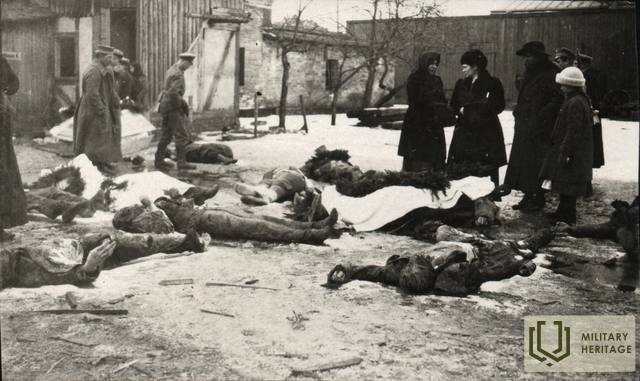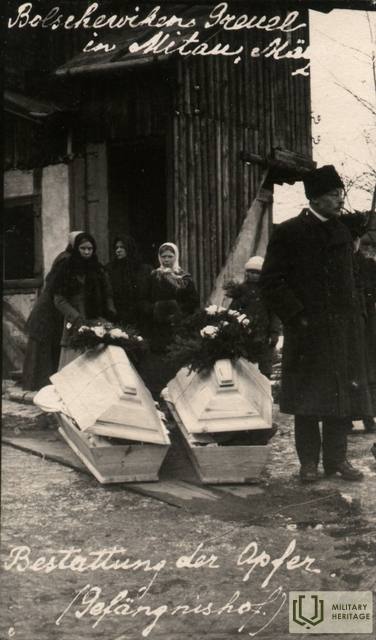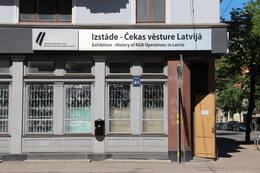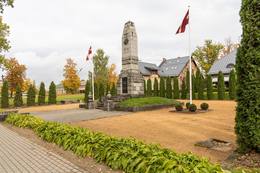Sarkanais terors I WW1, I Neatkarības kari

Sarkanais terors ir 1918. gada 5. septembrī ar dekrētu Krievijā pie varas esošā lielinieku režīma valdības - Tautas komisāru padomes (TKP), - izsludināta oficiāla politika: mērķtiecīga un leģitīma režīmam nevēlamu personu ieslodzīšana koncentrācijas kometnēs vai fiziska iznīcināšana bez apsūdzības, izmeklēšanas, tiesas un vainas pierādīšanas. Sarkanais terors oficiāli tika pārtraukts 6. novembrī, dienu pirms Oktobra revolūcijas gadadienas. Tomēr nežēlīgas represijas pret iedomātajiem un reālajiem boļševiku režīma pretiniekiem turpinājās un parasti Sarkanā terora noslēgumu saista ar Krievijas Pilsoņu kara beigām 1922. gadā.
Oficiālais iemesls bija sociālrevolucionāres Fanijas Kaplānes (1890-1918) neveiksmīgi īstenotais atentāts pret Ļeņinu, kura rezultātā lielinieku līderis tika ievainots. Pēc ziņas saņemšanas par atentātu pret Ļeņinu Viskrievijas Centrālā izpildkomiteja aicināja uzsākt nesaudzīgi masu teroru pret revolūcijas ienaidniekiem. Tomēr oficiālu lēmumu par Sarkanā terora sākumu pieņēma Padomju Krievijas valdība - Tautas komisāru padome (TKP) - 1919. gada 5. septembrī. Galvenā institūcija, kas īstenoja Sarkano teroru, bija Viskrievijas ārkārtas komisija un tai pakļautās dažādās represīvās struktūras, kā arī lielinieku aktīvisti pēc pašu iniciatīvas. Jau pirmajā sarkanā terora dienā Petrogradā noslepkavoja vairāk nekā 500 režīmam nevēlamu cilvēku vai vienkārši “aizdomīgu” (pārāk labi ģērbti vai zināmi kā inteliģenti, virsnieki, bijušie ierēdņi vai vienkārši turīgi cilvēki) personu. Kopā šīs politikas gados tika nogalināts vairāk nekā 1 200 000 cilvēku.
Viens no idejas autoriem un galvenajiem ideologiem bija ievērojamais čekists Mārtiņš Lācis (Jānis Sudrabs; 1888-1938), kurš šo koncepciju izstrādāja un popularizēja: "Mēs nekarojam pret atsevišķām personām. Mēs iznīcinām buržuāziju kā šķiru. Izmeklēšanā nemeklējiet materiālu un pierādījumus, ka apvainotas darbos vai vārdos darbojies pret padomju varu. Pirmais jautājums, kuru jums viņam jāpiedāvā - kādai šķirai viņš pieder, kāda viņam ir izcelsme, audzināšana, izglītība vai profesija. Šiem jautājumiem arī jānosaka apsūdzētā likteni. Tā ir sarkanā terora jēga un būtība."
Vēl viens latvietis Jēkabs Peterss 1918. gada rudenī bija čekas priekšnieka Fēliksa Dzeržinska vietnieks. Čekas aparātā šajā laikā strādāja vairāki simti latviešu. No otras puses, arī boļševiku nogalināto vidū bija daudz latviešu, un daudzi, piemēram, Latviešu pagaidu nacionālās padomes locekļi, bija spiesti slēpties vai bēgt no Krievijas, lai glābtu dzīvību. Pēc boļševiku iebrukuma Latvijā 1918. gada novembrī arī šeit sākās Sarkanais terors, kurš prasīja vismaz 2-3 tūkstoš cilvēku dzīvības. Katrā Latvijas apriņķī lielinieki izveidoja revolucionāros tribunālus; tika radītas vairākas koncentrācijas nometnes (lielākā Pļaviņās); režīmam nevēlamās personas medīja lielinieku slepenpolicija – politiskās apakšnodaļas. 1919. gada pavasarī Latvijā sākās masveida nāvessodu izpildīšana. Tūkstošiem cilvēku tika ņemti kā ķīlnieki un ievietoti cietumos, kuros valdīja netīrība un plosījās epidēmiskās slimības (gripa, tīfs u.c.).
Papildus izziņas avoti
https://vesture.eu/Sarkanais_terors
https://www.lsm.lv/raksts/dzive--stils/vesture/kas-un-kapec-jazina-par-sarkano-teroru-krievijas-pilsonu-kara-laika.a291271/
https://www.dveseluputenis.lv/lv/laika-skala/notikums/107/bads-un-sarkanais-terors-kurzeme-un-vidzeme/
Saistītās laikalīnijas
Saistītie objekti
Stūra mājas izstāde "Čekas vēsture Latvijā"
Atrodas Rīgā, Brīvības un Stabu ielu krustojumā.
1911. gadā būvētais nams ir viens no skaistākajiem Rīgā. Tautā saukts par “Stūra māju”, ir baisākais Padomju okupācijas režīma simbols Latvijā. “Čeka” bija īpaši represīva struktūra - viens no PSRS varas balstiem. Tās darbība Latvijā cieši saistīta ar ēku Brīvības un Stabu ielas stūrī.
“Stūra mājā” čeka darbojās okupācijas laikā no 1940.gada līdz 1941. gadam un atkal, sākot no 1945.gada līdz 1991. gadam. Politiskās vajāšanas tiešā veidā skāra ap desmitiem tūkstošu Latvijas iedzīvotāju. Padomju varas pretinieku apkarošana turpinājās arī pēc 2. pasaules kara. Čekas darbības metodes nedaudz mainījās pēc Staļina nāves. Fizisku mocīšanu nomainīja psiholoģisks terors. Vairākums čekas aģentu bija latvieši (52%). Krievi bija otrā lielākā grupa - 23,7 %. 60,3% aģentu nebija Komunistiskās partijas biedri. Augstākā izglītība bija 26,9% aģentu. Sistēma bija veidota, lai iesaistītu vietējos iedzīvotājus un tādējādi panāktu kontroli pār sabiedrību. Čekas darbības metodes Latvijā nav pilnībā izpētītas. Darbinieku saraksti un dienesta lietas atrodas Krievijā. Latvijas varas iestādēm un pētniekiem tās nav pieejamas.
Mūsdienās var aplūkot Latvijas Okupācijas muzeja izstādi par “čekas” darbību Latvijā. Kopā ar gidu var izstaigāt cietuma kameras, gaiteņus, pagrabu un iekšpagalmu.
Piemineklis par Latvijas brīvību kritušajiem Gulbenes draudzes varoņiem
Atrodas Gulbenes vēsturiskajā centrā pretim Gulbenes Evaņģēliski luteriskajai baznīcai.
Piemineklis 1905. gada nemieru upuriem, Pirmajā pasaules karā un Latvijas Brīvības cīņās kritušajiem Gulbenes draudzes locekļiem un Malienas tribunāla upuriem. Piemineklis veidots pēc E. Ābeltiņa meta, atklāts 1929. gadā pretī Gulbenes evaņģēliski luteriskajai baznīcai. Pēc Otrā pasaules kara piemineklim uzlikta piecstaru zvaigzne, tad - uz tā pamatiem - bronzas krāsā krāsots ģipša padomju karavīra tēls, bet aiz pieminekļa ierīkoti kritušo padomju karavīru kapi. Kad 1969.gadā Spārītes parkā tika atklāti jaunie Otrajā pasaules karā kritušo padomju karavīru kapi, kritušo mirstīgās atliekas pārveda tur, bet pieminekļa vietu nolīdzināja līdz ar zemi. 1989.gada rudenī tika atrakti pieminekļa pamati un izcelta 1928.gadā tajos iemūrētā kapsula ar tekstu. Piemineklis atjaunots 1992. gadā (tēlnieks O. Feldbergs).
Laikā no 1918.gada 24.decembra līdz 1919.gada 31.maijam, kad 1.(4.) Valmieras kājnieku pulks atbrīvoja Gulbeni no lieliniekiem, baznīcā atradās Malienas (Vecgulbenes) revolucionārais kara tribunāls un strādnieku klubs. Tā darbība izcēlās ar pieņemto lēmumu bardzību un nāves sodu lielo daudzumu, bieži vien par niecīgiem pārkāpumiem - tika uzsākta 349 lietu izmeklēšana, tajās apvainotas 606 personas.
Redzama piemiņas skulptūra.
Deportāciju piemiņas vagons - muzejs pie Skrundas stacijas
Deportāciju vagons atrodas Skrundas stacijā pie pasažieru perona.
Vagons un pie tā esošais piemineklis veltīts 1941. un 1949. gada deportācijās cietušajiem Skrundas un tuvāko pagastu iedzīvotājiem. Piemiņas vieta iekārtota un atklāta 1998. gada 25. martā, bet vagons un ekspozīcija atjaunoti 2020. gadā. Ekspozīcijā redzami no tuvākās apkārtnes izsūtīto iedzīvotāju saraksti, aplūkojamas fotogrāfijas un lasāmi stāsti par izsūtījumā pieredzēto.
Skrundas stacija bija izvešanai nolemto cilvēku savākšanas punkts, viena no trim apriņķa stacijām, uz kuru tika atvesti cilvēki gan no Skrundas, gan Kuldīgas apkārtnes. 1941. gadā no šejienes uz Sibīriju, Krasnojarskas novadu izveda arī atjaunotās Latvijas Republikas pirmā prezidenta Gunta Ulmaņa ģimeni.
Šādos un līdzīgos preču vagonos padomju okupācijas vara 1949. gadā deportēja Latvijas iedzīvotājus, kurus atzina par potenciāli bīstamiem padomju varai, balstoties uz viņu piederību nosacīti turīgākajam zemnieku slānim. Ar deportāciju palīdzību padomju vara izrēķinājās ar Nacionālo partizānu atbalstītājiem un vienlaikus iebiedēja palikušos lauku iedzīvotājus, piespiežot tos iestāties kolhozos.
Vagons ikdienā ir aizslēgts - vagona atslēga pieejama Skrundas stacijā pie dežuranta.
Komunistiskā terora upuriem veltītas piemiņas vietas izveides ideja pieder skrundeniekam Ivaram Eņģelim. Vagonu muzejam piešķīra VAS ”Latvijas dzelzceļš”. Skrundenieki Jelgavas pusē atrada šo vagonu, paši saviem spēkiem to uzstādīja Skrundā un izremontēja. Vagonam, kā uzskata paši dzelzceļnieki, ir liela vēsturiska vērtība. Tas būvēts piecdesmitajos gados, un tieši šādos lopu vagonos tika izvesti Latvijas iedzīvotāji.
1941. gada 14. jūnijā un 1949. gada 25. martā padomju okupācijas režīms realizēja Latvijas iedzīvotāju masveida deportācijas, no Latvijas izsūtot desmitiem tūkstošu cilvēku, tai skaitā bērnus, sirmgalvjus un sievietes mātes cerībās. Tikai retajam izdevās paņemt līdzi siltas drēbes un pārtiku. Daudzi mira pa ceļam uz Sibīriju, daudziem nācās sākt jaunu, grūtu dzīvi tālā, svešā zemē…
Ekspozīcija „Latvijas armija Pļaviņās 20. gs.”
Atrodas Odzienas ielā 2, Pļaviņās.
Apskatāma pastāvīgā ekspozīcija „Latvijas armija Pļaviņās 20. gs.”.
Ēkai Pļaviņās, Odzienas ielā 2, ir sena vēsture – no laika, kad Stukmaņu lieltirgotājs Hugo Apeltofts tajā uzsāka aktīvu saimniecisko darbību, tādējādi veicinādams Pļaviņu pilsētas attīstību, līdz brīdim, kad Brīvības cīņu jeb Neatkarības kara laikā šeit tika izveidots Latvijas Austrumu frontes štābs. 1919. gadā tieši no Pļaviņām tika vadīta Latvijas armijas vienību darbība pret Sarkano armiju Latgalē.
1934. gadā pie šī nama tika atklāta piemiņas plāksne ar uzrakstu: “Šai namā 1919. gadā atradās Austrumu frontes štābs, un šeit ģenerālis Jānis Balodis uzņēmās Latvijas Nacionālās armijas virspavēlniecību.” Padomju vara 1940. gadā to noņēma un iznīcināja, bet 1990. gada 16. jūnijā ar LNNK Pļaviņu nodaļas atbalstu tā tika atjaunota.
Tagad pie kādreizējā štāba ēkas atrodas piemiņas stēla, kas veltīta 15 Pļaviņu novadā dzimušajiem Lāčplēša Kara ordeņa kavalieriem, bet telpās izveidota ekspozīcija „Latvijas armija Pļaviņās 20. gs.”, kura stāsta par notikumiem Brīvības cīņu laikā, Latvijas armijas 3. Latgales divīzijas štāba darbību Pļaviņās, kā arī sniedz ieskatu Lāčplēša Kara ordeņa kavalieru dzīves stāstos.
Netālu no ekspozīcijas ēkas atrodas Latgales divīzijas štāba ēka, kuru 1913. gadā, kā Stukmaņu liķiera fabiku būvēja grāfs Teodors Medems. 1919.gadā to pārņēma P. Stučkas režīms, kur tas bija izveidojis arī cietumu. Pēc boļševiku padzīšanas, 1925.gadā ēku pārņēma Latvijas armija, kura tajā izvietoja Latgales divīzijas štābu. Šajā ēkā savu militāro karjeru izgāja 10 Latvijas armijas ģenerāļi un citi virsnieki. 1940.gadā ēku pārņēma Sarkanā armija. Pēckara gados tajā izvietojās skola, kā arī pašvaldība. Ap 1970.gadu ēku sāka izmantot ražošanas apvienība “Rīgas Apģērbs”.
Ekspozīcijas apmeklējumu iepriekš jāpiesaka zvanot T. 28442692.
Latgales Kultūrvēstures muzejs
Latgales Kultūrvēstures muzejā Rēzeknē apskatāmas trīs pastāvīgās ekspozīcijas. Viena no tām – “Rēzekne laikme tu griežos” – stāsta par pilsētas vēsturi septiņu gadsimtu garumā. Nozīmīga daļa ir veltīta tieši 20. gadsimta noti kumiem, kariem un laikmetu maiņām: Pirmajam pasau les karam, Neatkarības karam, Otrajam pasaules karam, Rēzeknes sagraušanai 1944. gadā padomju bumbvedēju uzlidojumā, kā arī karagūstekņu nometnei “Stalag 347”. Ekspozīcijā ir fotostends par Rēzeknes karavīru likteņiem kara laikā.
Savukārt Latvijas brīvvalsts laikā Rēzeknē dislocētā Latvi jas armijas 9. Rēzeknes kājnieku pulka karavīri bija neat ņemama pilsētas sabiedriskās dzīves un sporta notikumu sastāvdaļa, it īpaši 11. un 18. novembra svinībās.











